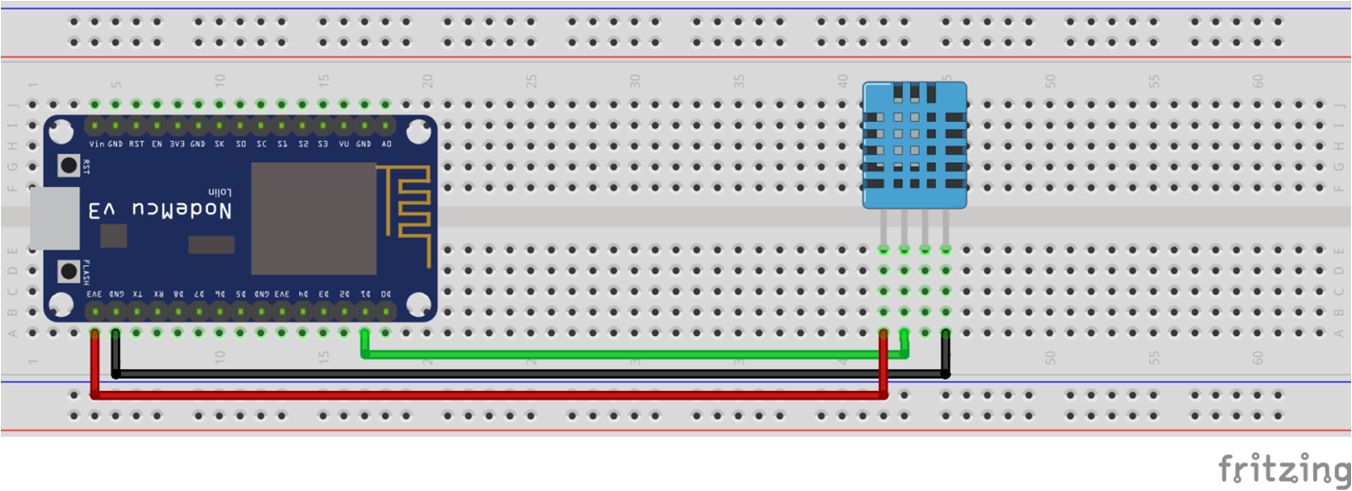In this article we will learn how to implement DHT11 Sensor with NodeMCU and ThingSpeak. If your are new to Internet of Things (IoT), learn about IoT by visiting our Internet of Things tutorial for beginners.
Contents
Aim of Experiment
To upload environmental sensor data to cloud server (ThingSpeak)
Components Required
- NodeMCU – 1
- DHT11 Sensor – 1
- Breadboard – 1
Connections Diagram (Schematic)
Code (C++/Arduino IDE)
#include<DHT.h>
#include<ESP8266WiFi.h>
String apiKey = "APIKEY";
const char* ssid = "SSID";
const char* password = "PASSWORD";
const char* server = "api.thingspeak.com";
#define DHTTYPE DHT11
const int DHT_pin = D1;
DHT dht(DHT_pin, DHTTYPE);
WiFiClient client;
void setup() {
// put your setup code here, to run once:
Serial.begin(9600);
Serial.print("Connecting to WiFi...with SSID: ");
Serial.println(ssid);
WiFi.begin(ssid, password);
Serial.println("Connecting...");
while(WiFi.status() != WL_CONNECTED){
delay(500);
Serial.print(".");
}
Serial.println();
Serial.println("WiFi connection successful!");
Serial.print("IP Address: ");
Serial.println(WiFi.localIP());
}
void loop() {
// put your main code here, to run repeatedly:
//Read the temperature
float t = dht.readTemperature();
delay(10); //necessary for reading correct values
//Read the humidity
float h = dht.readHumidity();
if(client.connect(server, 80)){
String postStr = apiKey;
postStr += "&field1=";
postStr += String(t);
postStr += "&field2=";
postStr += String(h);
postStr += "\r\n\r\n";
client.print("POST /update HTTP/1.1\n");
client.print("Host: api.thingspeak.com\n");
client.print("Connection: close\n");
client.print("X-THINGSPEAKAPIKEY: "+apiKey+"\n");
client.print("Content-Type: application/x-www-form-urlencoded\n");
client.print("Content-Length: ");
client.print(postStr.length());
client.print("\n\n");
client.print(postStr);
delay(1000); //necessary for posting to ThingSpeak
Serial.print("Temperature: ");
Serial.print(t);
Serial.print(" centi, Humidity ");
Serial.print(h);
Serial.println("%");
Serial.println("Data sent to ThingSpeak");
}
client.stop();
Serial.println("Waiting for 15sec...");
//ThingSpeak needs min. 15sec delay between each data post
delay(15000);
}
Video Explanation

Suryateja Pericherla, at present is a Research Scholar (full-time Ph.D.) in the Dept. of Computer Science & Systems Engineering at Andhra University, Visakhapatnam. Previously worked as an Associate Professor in the Dept. of CSE at Vishnu Institute of Technology, India.
He has 11+ years of teaching experience and is an individual researcher whose research interests are Cloud Computing, Internet of Things, Computer Security, Network Security and Blockchain.
He is a member of professional societies like IEEE, ACM, CSI and ISCA. He published several research papers which are indexed by SCIE, WoS, Scopus, Springer and others.




Leave a Reply